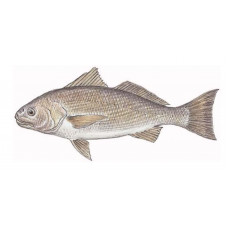Latin name
Genyonemus lineatus
Other names
Kingfish, king-fish, king croaker, shiner, Pasadena trout, tommy croaker, little bass, shiroguchi
Identification
The body of the white croaker is elongated and compressed. The head is oblong and bluntly rounded, and the mouth is slightly below the head. A deep notch separates the two dorsal fins. The dorsal coloration is iridescent, from brown to yellowish, becoming silvery underneath. Faint wavy lines appear on the silvery areas. The fins are yellow to white. The white croaker is one of the five California croakers with a subterminal mouth.
Distribution
The white croaker is common from Magdalena Bay, Baja California, to Vancouver Island, British Columbia, and is not abundant north of San Francisco.
Habitat
Preferring sandy bottoms, white croaker inhabit quiet surf zones, shallow bays, and lagoons. Most of the time they are found in offshore areas at depths of 10 to 100 feet. On rare occasions, they are abundant at depths as great as 600 feet.
Size
The average weight is 1 pound. It is believed the white croaker can live up to 15 years, although most live far fewer years.
Life history and Behavior
Spawning usually occurs from March to September, with a peak in late spring to early summer.
Food and feeding habits
The white croaker consumes a variety of fish, squid, shrimp, octopus, worms, small crabs, clams, and other live or dead objects.
Reproduction
Releases gametes into the water for fertilization, usually at night, to reduce attack on the eggs, which are the largest (0.5 inch diameter) of all humpbacks on the West Coast. Age of maturity has not been determined.
| Classification | |
| Phylum | Chordata |
| Class | Actinopterygii |
| Squad | Acanthuriformes |
| Family | Sciaenidae |
| Genus | Genyonemus |
| Species | G.lineatus |
| Features | |
| Conservation status | Least Concern |
| Habitat | bottom |
| Life span, years | 15 |
| Maximum body weight, kg | 0.65 |
| Maximum length, cm | 41.4 |
| Sailing speed, m/s | No information |
| Threat to people | Edible |
| Way of eating | Omnivore |


